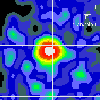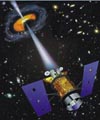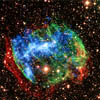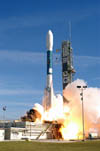News Archive: Gamma-ray Bursts
![]()
News Archive: Gamma-ray Bursts
 |
Reboosting the Compton Gamma-Ray Observatory [18 Feb 1997] - The Compton Gamma-Ray Observatory (CGRO) has been in Earth orbit for nearly six years now. In that time, observations from its 4-instrument complement have greatly expanded our understanding of the most energetic objects in the Universe. |
 |
Look, There in the Sky! It's a Gamma-Ray Burster? [27 Mar 1997] - What exactly is the source of a gamma-ray burst? Since their discovery in the early 1970s, nobody has been able to explain the cause of the mysterious flash of gamma-rays called a gamma-ray burst that seems to come from a random direction on the sky. Worse yet, it is even unclear whether these high-energy explosions originate in our own Galaxy or in distant galaxies across the Universe. Now, all of that may have changed! |
 |
Astronomers Detect Most Powerful Explosion Since Big Bang [18 May 1998] - The energy released in a cosmic gamma-ray burst detected in December 1997 is the most energy ever detected from an explosion in the Universe, perhaps making it the most powerful explosion since the creation of the Universe in the Big Bang. |
 |
SWIFT Satellite to Catch the Most Powerful Flashes of Light Known in the Universe [26 October 1999] - Once or twice a day, without warning, there are brief flashes of highly energetic light that momentarily outshine the rest of the universe. NASA has chosen to develop a mission that will be capable of capturing information about these unpredictable bursts of gamma-rays. |
 |
The Universe Lights Up on Beethoven's Birthday [30 December 1999] - Ludwig van Beethoven would have been impressed. On December 16, the 229th anniversary of the musician's birth, the Universe lit up in gamma rays that, for a few seconds, outshone the entire sky. |
 |
Hidden Gamma Ray Sources to be Exposed [14 March 2000] - The universe is a violent place. Stars explode. Galaxies collide. Gas and dust spin around black holes at incredible velocities until the black holes devour it all. Recent space telescope missions have given scientists a glimpse into the nature of these violent events and energetic objects. "GLAST" will give them a much better look. |
 |
Dishwasher-shaped Satellite to Catch Gamma-Ray Bursts [10 October 2000] - Gamma-ray bursts are explosions that represent the greatest release of energy in the Universe other than the Big Bang. Satellites detect several of these bursts a day, and scientists do not know what causes them. |
 |
"Local" Gamma-Ray Bursts Are Newest Pieces of Puzzle [28 January 2002] - Don't look now, but some gamma-ray bursts may be closer than you think. Although scientists have believed for some time that most gamma-ray bursts originate from the farthest reaches of the Universe, a NASA Goddard scientist has discovered about 100 of them that are quite "local," within 325 million light years from Earth. |
 |
Scientists Detect First Afterglow of Short Gamma-Ray Bursts [01 March 2002] - In the powerful realm of gamma-ray bursts, scientists say they have detected for the first time a lingering afterglow of the shortest types of bursts, which themselves disappear within a second. |
 |
Race To Gamma Ray Burst Reveals Gigantic Explosion, Death, & Birth [24 March 2003] - Scientists arriving on the scene of a gamma ray burst, just moments after the explosion, have witnessed the death of a gigantic star and the birth of something monstrous in its place, quite possibly a brand-new, spinning black hole. |
 |
NASA Detects One Of Closest And Brightest Gamma Ray Bursts [16 May 2003] - The Universe clearly works weekends; delivering one of the brightest and closest gamma ray bursts yet on Saturday, March 29, at 6:37 a.m. EST. |
 |
Burst Behind the Sun Reveals Magnetic Charm of Distant Explosion [10 June 2003] - Sometimes astronomers plan for years to make a crucial scientific discovery, building a telescope to precise specifications, launching it into space, and conducting a series of long, careful surveys of stars and galaxies. |
 |
Rosetta Stone Decodes Gamma-Ray Burst Mystery [26 June 2003] - Scientists have pieced together the key elements of a gamma-ray burst, from star death to dramatic black hole birth, thanks to a "Rosetta stone" found on March 29, 2003. |
 |
Smoking Gun Found for Gamma-Ray Burst in Milky Way [17 June 2004] - Scientists have uncovered evidence that a gamma-ray burst occurred in our own Galaxy only a few thousand years ago. They found this evidence by studying the supernova remnant, W49B, with the Chandra X-ray Observatory and the Palomar 200-inch telescope. W49B is a barrel-shaped nebula located about 35,000 light years from Earth. The new data reveal bright infrared rings, like hoops around a barrel, and intense X-radiation that together indicate that this may be the first remnant of a gamma-ray burst discovered in the Milky Way. |
 |
NASA Successfully Launches Swift Satellite [22 November 2004] - NASA's Swift satellite successfully launched on 20 November 2004 aboard a Boeing Delta 2 rocket at 12:16 p.m. EST from Launch Complex 17A at the Cape Canaveral Air Force Station, Fla. The satellite will pinpoint the location of distant yet fleeting explosions that appear to signal the births of black holes. |
 |
Cosmic Explosion Among the Brightest in Recorded History [25 February 2005] - Scientists have detected a flash of light from across the Galaxy so powerful that it bounced off the Moon and lit up the Earth's upper atmosphere. The flash was brighter than anything ever detected from beyond our Solar System and lasted over a tenth of a second. NASA and European satellites and many radio telescopes detected the flash and its aftermath on December 27, 2004. |
 |
NASA Scientists Catch Unique Gamma-Ray Burst [24 May 2005] - After 30 years, they finally caught one. Using the Swift satellite, scientists for the first time detected and pinned down the location of a so-called "short" gamma-ray burst, one lasting only 50 milliseconds. |
 |
NASA'S Swift Satellite Provides New Insight into Black Hole Formation [22 August 05] - Baby black holes apparently come into the world kicking and screaming, not unlike humans. Scientists using NASA's Swift satellite say they have found newborn black holes, just seconds old, in a confused state of existence. The holes are consuming material falling into them while somehow propelling other material away at great speeds. |
 |
Most Distant Explosion Detected, Smashes Previous Record [30 September 2005] - Scientists using NASA's Swift satellite and several ground-based telescopes have detected the most distant explosion yet, a gamma-ray burst from the edge of the visible universe. |
 |
In a Flash NASA Helps Solve 35-year-old Cosmic Mystery [07 October 2005] - Scientists have solved a 35-year-old mystery of the origin of powerful, split-second flashes of light called short gamma-ray bursts. These flashes, brighter than a billion suns yet lasting only a few milliseconds, have been simply too fast to catch... until now. |
Take Me to the Current News Page

